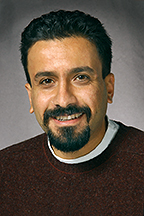This application-focused research project is going to explore how the introduction of 5G will revolutionise robotics.
Motivation
Robotics often makes leaps when new technologies from other domains are introduced. In this project, we want to investigate what 5G can do for robotics. Our aim is to implement a diverse range of relevant robotics applications and evaluate the impact of connectivity properties on them.
The following three applications can best describe our approach:
- Investigate how lower latency improves user experience for manipulator teleoperation with force feedback
- Leverage edge computing and high-throughput connections to process RGB-D data on off-board GPU clusters
- Scale real-time low latency collaborative mapping and collision avoidance to large robot fleets
Outline

The project is a collaboration between three labs, their share is depicted in the columns above. The project aspect
Evaluate is concerned with implementing typical robotics building blocks, optimising these together with the network, and documenting the performance.
Verify is about novel, compact teleoperation interfaces with haptic feedback and user perception of the network performance through those devices.
Compare focuses on scaling the previously conducted research to a real-world intralogistics scenario and understanding connectivity requirements of tightly-coupled distributed algorithms.
Available positions
Six positions in total are available within this project. Further details are given below.
The positions have aspects of independent work, leading to independent publications and thesis-relevant results. They also have aspects of intense collaboration to enable swift progress in this cross-domain project.
Overall project goals
- Compare and document the performance of robotics applications using 5G and Wi-Fi
- Understand which network properties are most relevant for which application
- Analyse the scalability of applications running on fleets
- Provide traffic patterns typical for robotics applications
- Verify application performance when using 5G mmWave and roaming between multiple cells
People
William Melek

William Melek is the director of the Robohub and a Professor in the Department of Mechanical and Mechatronics Engineering at the University of Waterloo. His research focus is in mechatronics and machine learning.
George Shaker

Prof George Shaker is a wireless and IoT expert, with a huge industrial experience. He is a professor of Department of Mechanical and Mechatronics Engineering as well as the Department of Electrical and Computer Engineering and leads the wireless sensors and devices lab.
Oliver Schneider

Prof Oliver Schneider is a professor at the University of Waterloo in the Faculty of Engineering (Department of Management Sciences). His research focus is in human-computer interaction, specifically haptic technology.
Alexander Werner

Alexander Werner is a researcher at the RoboHub. His focus is on control of complex robotic systems, centered around torque/force control systems.
Brandon DeHart

Prof DeHart is the Manager of the RoboHub. His research focus is span from bioinspired robot design over interactive architecture and includes bipedal locomotion.

